The commotion that drew me outside my writing studio one pleasant mid-winter morning was a veritable dissonant cacophony of repetitious discord; the din lacked any semblance of harmonic rhythm, like a jack hammer punching metal on a row of rusty cars.
I grabbed my camera and sneaked out doors. The clamorous clatter, I quickly learned, was the announcement of an annoyance of gregarious grackles.
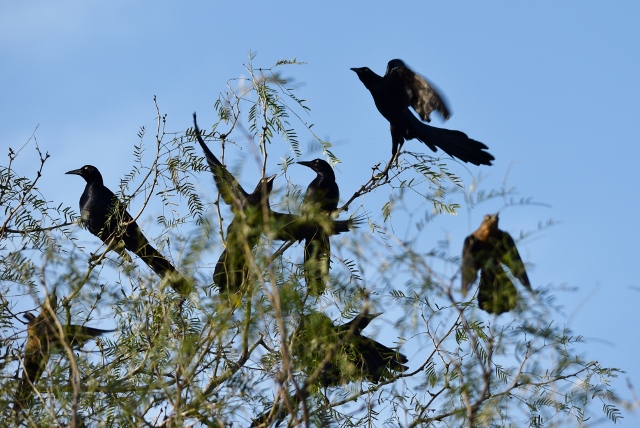
I’d noticed waves of great-tailed grackles up the road earlier in the week, thinking how lucky we were they weren’t converging on our yard. And then, there they were.
I raised the camera. The movement caused an instant flurry of flapping wings, and the birds were gone.
Rather quickly, they were back again, in a bickering battle, squawking and tittering, nagging and screeching, hopping and flapping amongst the tree limbs; one nattering Nellie was outright in-your-face ratchetting at another like a puffed-up drill sergeant, barking demerit-worthy grievances. I tried channeling my inner bird psychiatrist to understand what all the aggressive noises meant, each nuance, screech, whistle, clatter and nag. No such luck.
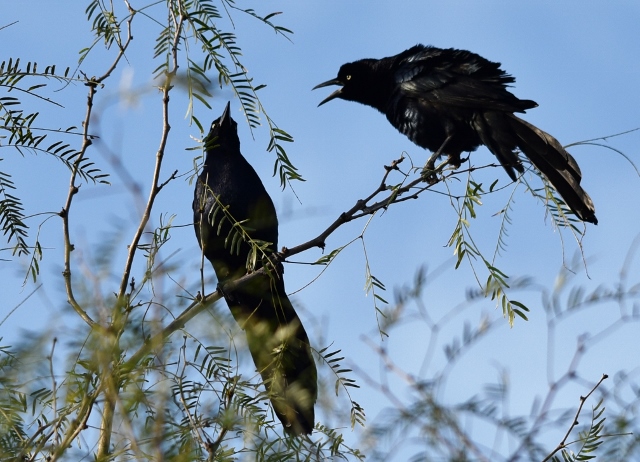
Researching many links on the Internet, I found that great-tailed grackles are social, conspicuous, noisy, gregarious and vacuous with an impressive array of sounds described as shrieks, clacks, whistles, chatters, and piercing, ascending whistles; but nothing that told what any of it meant.
I found a site that said they are intelligent, resourceful, playful and happy birds. So, all that fuss was just life on the wing, status quo, like a fun time on the playground. That makes it easier to accept the visitors, knowing they’re a happy lot.

Many of us are familiar with the great-tailed grackles’ pre-bedtime activity of gathering on powerlines near supermarket, restaurant and fast-food parking lots at dusk, prior to the birds heading to the trees to roost for the night.
But, what’s with these huge clouds of daytime grackles, swarming the county skies like the roar of motorcyclists exiting Sturgis at the end of a gathering? Red-wing blackbirds exhibit such great numbers at certain times of the year, but I’ve never seen grackles communally foraging in such masses — and I think I found an answer: There are reportedly 10 million great-tailed grackles in their range which encompasses the countries from northwestern Venezuela and Colombia, through Mexico and the U.S. and into southern Canada. In winter, many of the northern ones come south, swelling the Valley’s flocks to gargantuan proportions. These winter delegations can become assemblies of up to half a million birds converging on field crops and fallow fields.
A group of great-tailed grackles is collectively known as a plague or an annoyance, which emphasizes just exactly how humans view these birds’ mob characteristics.
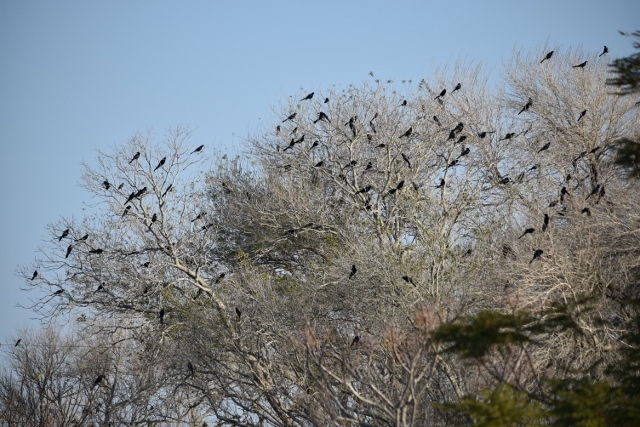
Considered a medium-sized bird, the males appear overall glossy black until the sun hits them at certain angles, revealing iridescent hues in brilliant copper, amethyst, green and purple. The females are about half the size of the males, are buff-cinnamon and brown in color with a faint iridescent purple patch at each shoulder. Both males and females have yellow eyes.
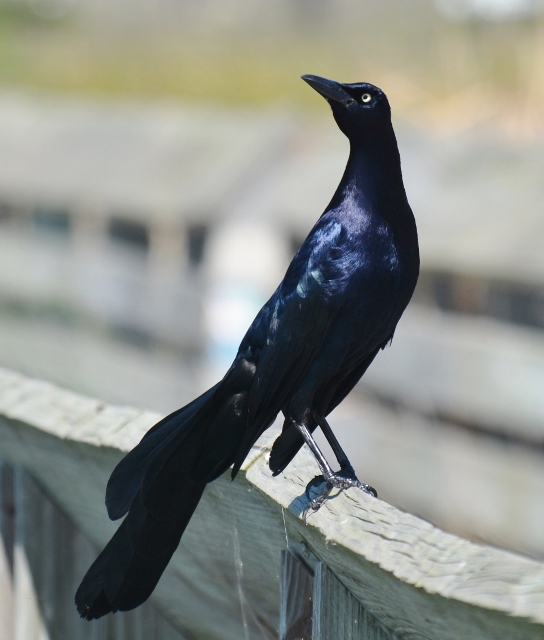
I think great-tailed grackles are fun to watch. On the ground or other surface, they strut with a cocky prance; they walk the walk — with a lot of attitude — and certainly, they talk the talk.
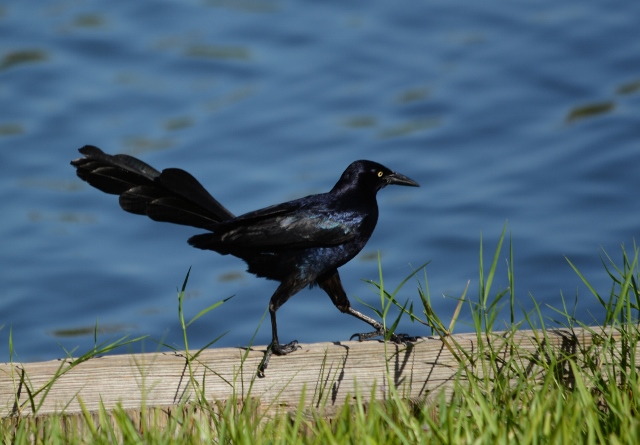
The species is thoroughly urbanized; they thrive among humans. Brash and brave, they have no compunction approaching diners at food courts to cadge a morsel of food. The birds’ adaptive behavior has allowed them to embrace such culinary delights as tacos, French-fries, biscuits and other offerings abandoned on parking lot pavements.
This modern sub-nutritious behavior hasn’t seemed to have affected the health of the species; they’re going strong, multiplying seemingly more than exponentially and ever-expanding their north and westward range. In 1900, the northern edge of their range barely reached southern Texas. Since the 1960s, they’ve wisely followed the spread of irrigated agriculture and urban development and taken it completely to their advantage.
The birds are at ease in developed and rural areas alike. By nature, they are omnivorous and opportunistic, noted for their diverse foraging habits — which are as impressive and varied as the repertoire of their vocalizations: they unearth larvae and insects from grass, turn over objects to get at crustaceans, insects and worms; they eat lizards, frogs, snakes, mice, shrews, nestlings and eggs; they forage in freshly plowed land, remove parasites from cattle, and eat fruits, such as bananas and berries.
They eat plant matter year-round and feed on grains, like maize, sorghum, and oats and eat corn, still on the cob, by opening the husks. They hunt tadpoles and fish by wading into shallow water; they do not swim but catch fish by flying close to the water’s surface. They also will pick dead insects off vehicle license plates. Their prey include grasshoppers, beetles, spiders, bees, wasps, snails, worms, slugs and moths.
With such diverse eating habits and adaptive behavior, the species is quite secure. Also going for them, they obviously subscribe to the old adage: safety in numbers.
Toward the middle of the afternoon of the Day of the Grackles, after a pass of the riding mower under the ash trees in our yard, a throng of great-tailed grackles descended on the fresh-mown grass. At the mower’s return pass, the birds flapped to the tree tops; after another pass, the birds, in successive contingents, gravitated to the freshly plowed farm field adjacent to our land. As I mowed close to the fence, up they’d go again to the tips of the uppermost tree branches. I was winding up my chore when, on some seemingly imaginary command, the grackles undulated en masse from the trees to the field again.
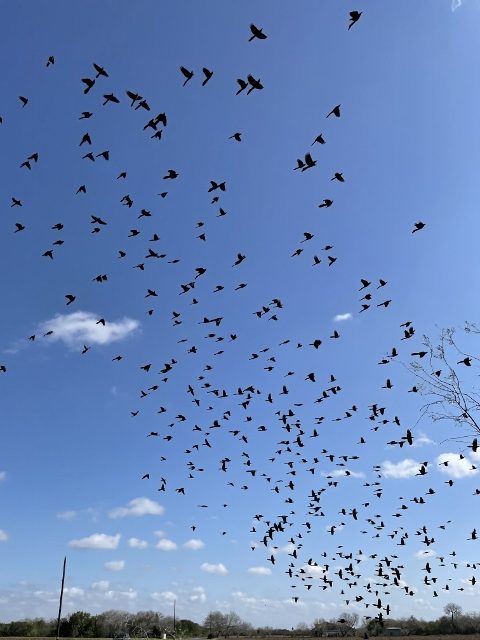
The next day, not a trace — nary a shiny black feather tumbled along the ground in the wind nor a rusty-gate-hinge screech pierced the quiet morning air.
– 30 –
Helpful sources in writing this include: biodiversity.utexas.edu, allaboutbirds.org, audubon.org, whatbird.com, wideopencountry.com, animaldiversity.org, abcbirds.org, txtbba.tamu.edu